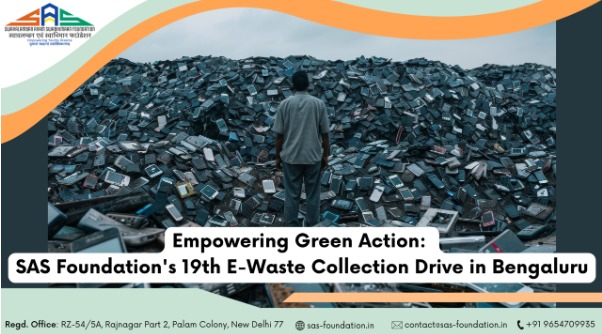Every Discarded Device Tells a Story: Why Recycling E-Waste Matters Now More Than Ever
We live in a world where technology evolves faster than we can keep up. Each year, newer, sleeker, and faster devices hit the market—and old ones are pushed aside. But what happens to the smartphones we once cherished, the laptops we no longer use, or the appliances that served us for a decade?
More often than not, they end up as e-waste—electronic waste that’s quietly piling up around the globe. And every single piece of it tells a story.
A story of innovation, consumption, neglect, and opportunity.
The Hidden Value of Discarded Devices
It’s easy to think of e-waste as junk. But inside every discarded device are materials and resources that are not only valuable but often scarce—gold, copper, aluminum, lithium, and rare earth metals.
Many of these materials are extracted through environmentally harmful mining practices, often in vulnerable communities. So, when we throw away electronics without recycling them responsibly, we waste precious resources and risk causing more environmental harm.
At the same time, many components in e-waste are toxic—mercury, lead, cadmium, and flame retardants can leak into our soil and water if not handled properly.
That’s why it’s so important to recognize what e-waste is, what types exist, and why recycling them isn’t just an option—it’s a necessity.
🔎 The 7 Major Types of E-Waste
1. Large Household Appliances
Think refrigerators, washing machines, air conditioners, and dishwashers. These are the heavyweights of e-waste, both literally and in environmental impact.
They contain:
- Heavy metals
- Insulation foam
- Coolants that can damage the ozone layer
Why recycle them?
These appliances contain valuable metals like steel and copper, and their parts can be reused. If thrown into landfills, they can leak gases that accelerate global warming.
2. Small Household Appliances
Items like toasters, hair dryers, irons, electric kettles, and vacuum cleaners fall into this category.
They’re often overlooked in recycling efforts, but they contain:
- Heating coils
- Wires and motors
- Plastic and circuit boards
Why recycle them?
Though smaller, they’re abundant and collectively add up to massive e-waste volumes. Recycling reduces unnecessary landfill bulk and retrieves usable materials.
3. ICT Equipment (Information & Communication Technology)
Laptops, desktops, routers, printers, and phones—tools we use daily for work, learning, and connection.
These devices often contain:
- Precious metals (gold, palladium)
- Lithium-ion batteries
- Plastic casings
Why recycle them?
Aside from resource recovery, proper recycling ensures data destruction—protecting your privacy. Also, improper battery disposal can cause fires or toxic leaks.
4. Consumer Electronics
Think televisions, DVD players, gaming consoles, radios, and music systems. These devices fuel our entertainment but become e-waste far too quickly as tech trends evolve.
Key materials include:
- CRTs (cathode ray tubes) with lead
- LCD screens with mercury
- Cables, wires, and boards
Why recycle them?
They’re rich in recyclable parts but dangerous when broken—especially CRTs. Safe dismantling prevents air, soil, and water pollution.
5. Lighting Equipment
Includes LED bulbs, tube lights, compact fluorescent lamps (CFLs), and smart lighting systems.
They contain:
- Mercury vapor (in CFLs)
- Small electronic circuits
- Rare earth materials
Why recycle them?
Broken bulbs can release mercury, a toxic substance. Recycling ensures mercury is safely extracted and the glass and metal components reused.
6. Power Tools and Electrical Equipment
This includes drills, electric saws, sewing machines, and gardening tools.
They often come with:
- Nickel-cadmium or lithium batteries
- Copper wiring
- Rotors and magnets
Why recycle them?
Their batteries are hazardous if punctured or burned. Responsible recycling helps recover copper and other components.
7. Medical and Monitoring Devices
Used in hospitals or homes—like thermometers, blood pressure monitors, and imaging equipment.
They may contain:
- Radioactive materials
- Batteries
- Sensitive data
Why recycle them?
These devices require special handling due to potential biohazards and radiation risks. Certified recyclers ensure safe, compliant disposal.
🌿 Why Responsible Recycling Is Essential
Improper e-waste disposal is a public health risk and an environmental disaster. Here’s what responsible recycling achieves:
1. Protects Health
Toxins like lead and mercury can cause neurological damage, respiratory illness, and even cancer when exposed to humans or animals.
2. Preserves Resources
Many rare minerals are finite and expensive to extract. Recycling gives them a second life—without environmental destruction.
3. Reduces Pollution
Safe processing prevents air, water, and soil contamination, especially in informal recycling sectors in developing countries.
4. Generates Green Jobs
The formal e-waste recycling industry creates employment opportunities—from logistics to dismantling, data wiping, and metal recovery.
5. Builds Circular Economy
Recycling allows recovered materials to be used in new products, reducing demand for virgin materials.
💡 What Can You Do?
Everyone has a role to play. Start with these small but powerful steps:
- ✅ Check for e-waste collection drives in your area
- ✅ Donate or resell functional electronics
- ✅ Avoid hoarding old tech in drawers
- ✅ Support certified e-waste recyclers
- ✅ Educate friends, family, and colleagues
Your actions inspire others.
🌱 The Role of Organizations Like SAS Foundation
At Swavalamban Avam Swabhimaan Foundation (SAS Foundation), we believe sustainability is a shared responsibility. Through awareness drives, workshops, school programs, and partnerships, we promote ethical and inclusive e-waste recycling practices across India.
We’re not just managing waste—we’re shaping a mindset shift. One that values what’s inside a discarded phone as much as what’s in a brand-new one.
📢 Final Thought: Every Device Matters
Every phone has a story. Every computer holds power beyond its processor. And every decision we make—whether to toss, store, or recycle—has a consequence.
By understanding the different types of e-waste and the value hidden within, we take a crucial step toward protecting our planet, empowering local communities, and closing the loop on consumption.
Let’s turn disposal into purpose.
Let’s give our old devices a new life—one that doesn’t end in a landfill.










